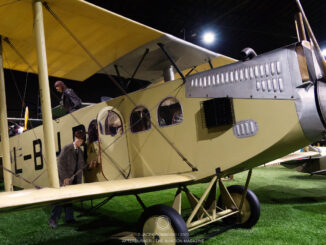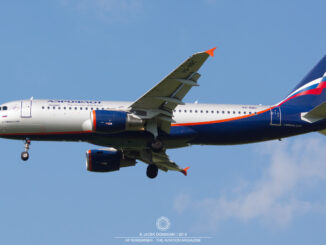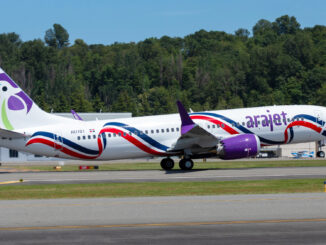 On 30th June 1956, a United Airlines DC-7 and a Trans World Airlines L-1049 Super Constellation collided in the air over Grand Canyon National Park in Arizona. All 128 people on board of both airliners were killed. The accident was the first in commercial aviation history to exceed one hundred casualties.
On 30th June 1956, a United Airlines DC-7 and a Trans World Airlines L-1049 Super Constellation collided in the air over Grand Canyon National Park in Arizona. All 128 people on board of both airliners were killed. The accident was the first in commercial aviation history to exceed one hundred casualties.
Two aeroplanes involved in that accident were:
- the Lockheed L-1049 Super Constellation ´Star of the Seine´, flown by crew Jack Gandy, James Ritner and Forrest Breyfogle. The aircraft was on the TWA Flight 2 route from Los Angeles to Kansas.
- the Douglas DC-7 ´Mainliner Vancouver´, piloted by Robert Shirley, Robert Harms and Girardo Fiore. The airliner was on its way from Los Angeles to Chicago, the UA Flight 718.
Initially, both aircraft were flying under instrument flight rules (IFR) and were under control of air traffic control (ATC). Although not directly – at that time, the ATC was not in personal touch with such passenger aircraft and all communication was done through the airline flight dispatchers. The Super Constellation was at an altitude of 5,800 metres (19,000 feet), while the DC-7 followed her at 6,400 metres (21,000 feet). After leaving California, the aeroplanes flew into the uncontrolled airspace over the Colorado territory.
During the flight, Capt. Gandy asked the ATC for permission to climb to 21,000 feet, the same altitude the DC-7 was flying at, to avoid thunderclouds. It was denied, as the ATC was aware of the second aeroplane and could not secure the distance between both airliners. Nevertheless, a bit later, Gandy repeated his request, this time asking for having 1,000 feet clearance above the clouds. This time it was allowed, however on condition that from now on the flight is maintained within visual flight rules (VFR). Therefore, the Super Constellation crew was responsible for keeping the necessary separation from any other aircraft.
Following the ATC approval, Gandy increased the altitude to 21,000 feet. Both aircraft were now approaching the area of Grand Canyon on a colliding course with 13 degrees angle.

Approximately at 10:30 a.m. local time, the airliners collided in mid-air. The Super Constellation crashed on the slope of Temple Butte mountain formation and the DC-7 hit the south cliff of Chuar Butte. Both aeroplanes literally disintegrated from the impact, scattering debris over the Canyon and instantly killing all people onboard.
The investigation that followed was long and complicated. In the mid-1950 airliners were not yet equipped with cockpit voice recorders nor flight data recorders, there was no radar coverage in the area and, because of the remote location, no eyewitnesses.
Final report concluded that the DC-7 hit the Super Constellation from behind, at angle of 25 degrees. Its left wing and engine propellers cut off the tail section of the L-1049 that caused immediate loss of control and near-vertical dive with an estimated speed of 770 kph. That conclusion was supported by the fact that vertical stabilizer of the Super Constellation was found relatively far away from other debris. The collision caused severe damage to the DC-7 left wing and engines. As a result, both lift and power were lost and the airliner went down rapidly in a deadly corkscrew.
The investigation also found that at least one of the pilots was trying to avoid the collision but the manoeuvre was performed too late. It was evidenced by the angle the aeroplanes collided and the position of both aircraft – the Super Super Constellation was ascending with right turn, while the DC-7 was sharply descending to the left. In addition, a hypothesis was put forward that both aeroplanes were separated by a cloud, passing it from different sides and therefore without possibility to see each other.
The 1956 Grand Canyon collision was one of the most echoing aviation accidents of the late 1950s. However, it was not the only one. The number of mid-air collisions, as well as last-second-avoided cases, was constantly increasing. Just four years later, the deadly record of 128 fatalities was surpassed by another mid-air collision that occurred over New York and killed 134 people. What´s more, it also involved TWA and UA airliners.
Eventually, the accident over the Grand Canyon triggered a discussion about safety of commercial aviation. Within the next years, ATC procedures were revised and then significantly upgraded. The Federal Aviation Act of 1958 was among the milestones that improved and regulated airspace safety and let to creation of the Federal Aviation Agency.
In 2014, the crash site was declared a National Historic Landmark. It remains closed to public since the disaster occurred there.
Cover photo: Lockheed L-1049 Super Constellation, N6902C, Star of the Seine (Wikipedia, Public Domain)



